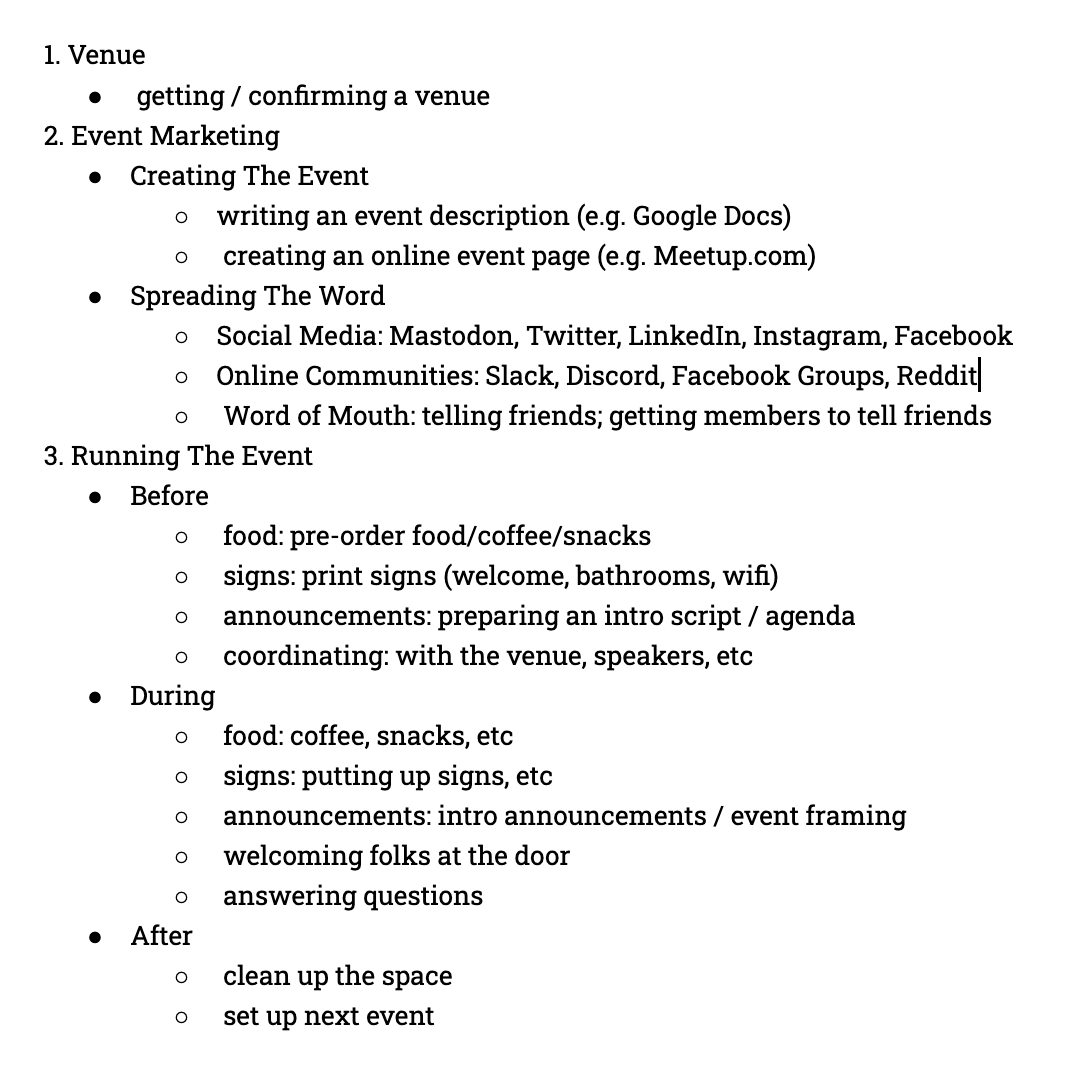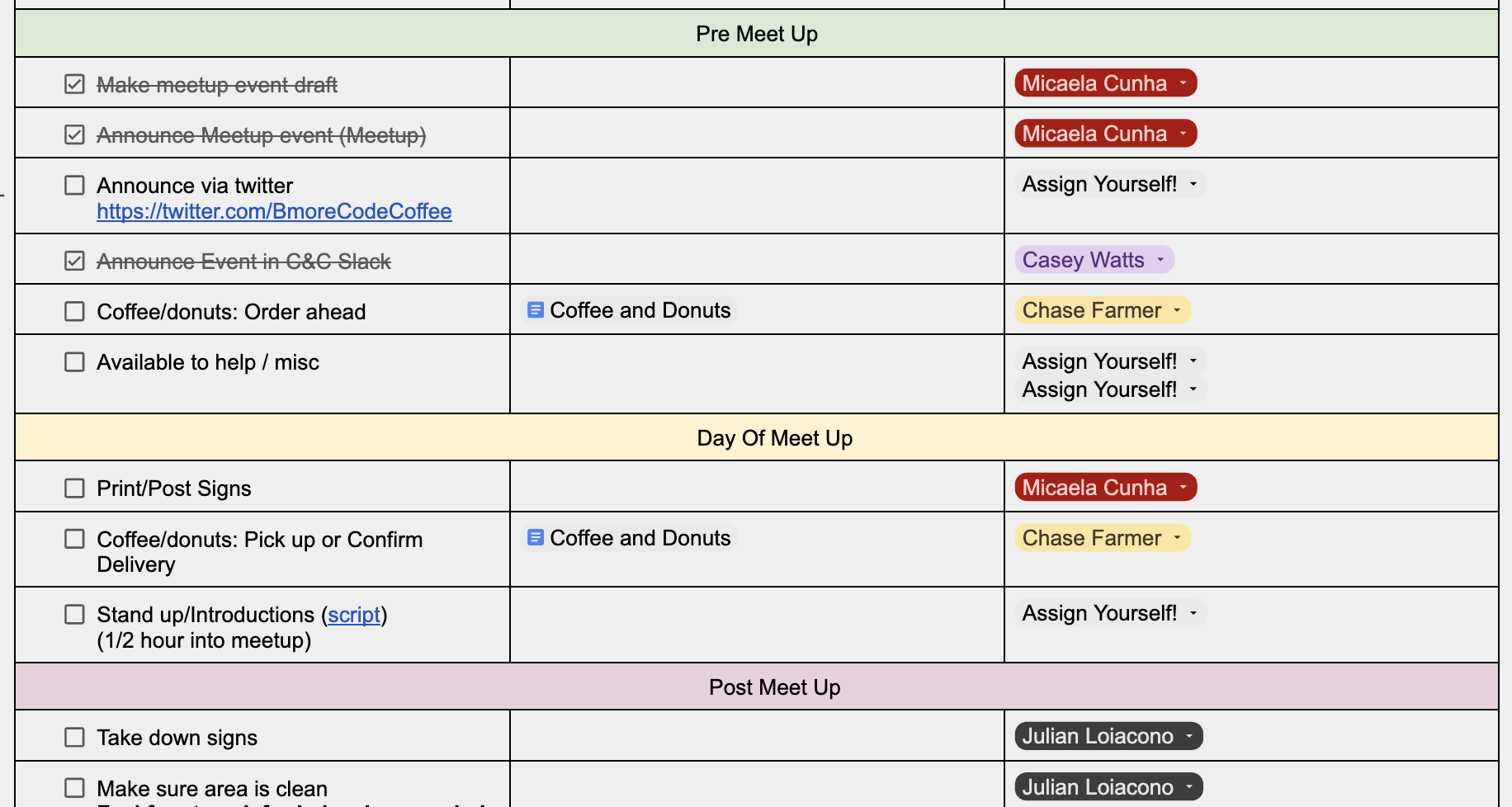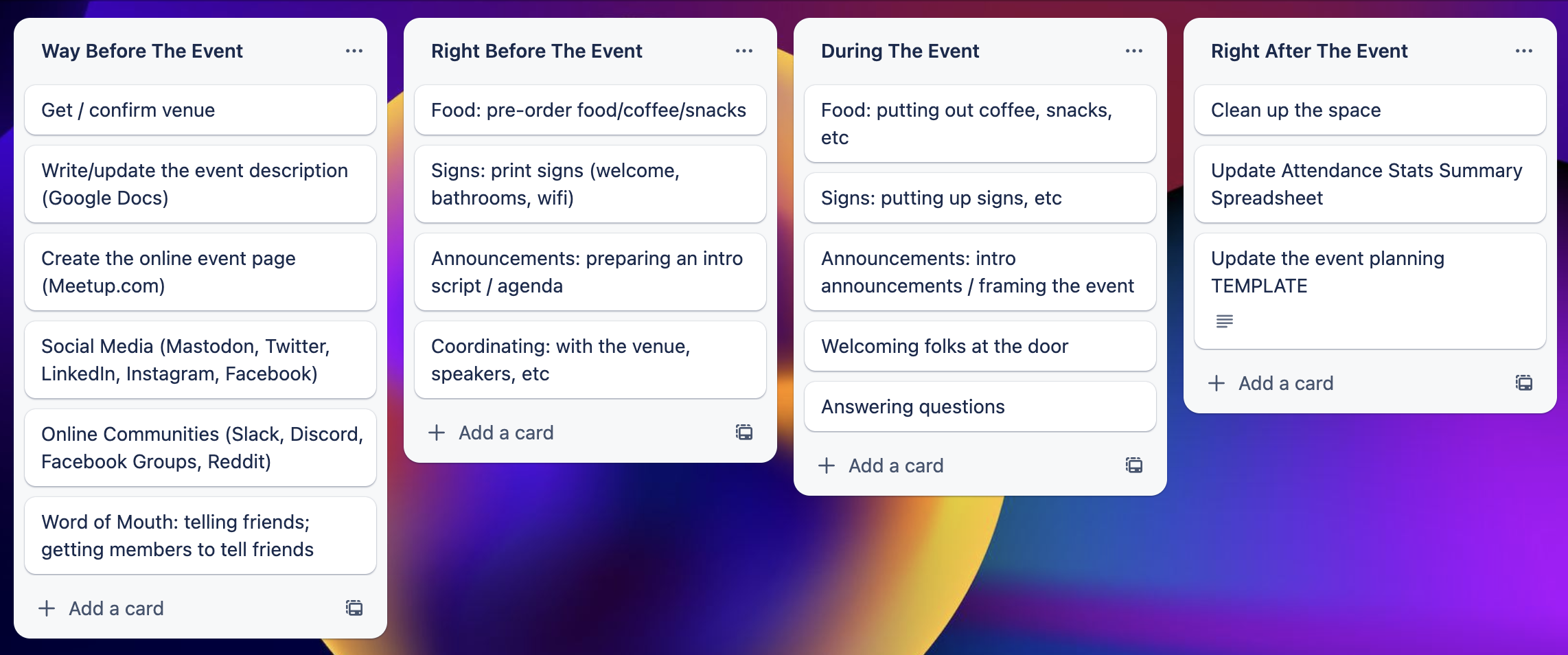Making an Event Happen
Are you a newer volunteer or organizer? Thank you for helping run an event! We need people like you for our communities to thrive 🙏
Are you an experienced organizer? You probably get asked this a lot whenever you ask for help: “what exactly would that entail?” — hopefully this article makes it easier for you to answer that question.
For this post I’m assuming your community group is community-focused and community-led. If your group is instead more of a marketing tool for a company, the advice here may not apply.
In This Article
This blog post includes:
- A checklist of what it takes to make an event happen
- How to divvy up tasks, so you aren’t organizing alone
- Some common concerns about delegating
- How to make it easy for volunteers to sign up for tasks
Making An Event Happen (Checklist)
What goes into making a local community event happen?
Three Phases
At a high level, there are three phases of hosting an event:
- Planning: Decide the who, what, when, where.
- Marketing: Tell people about it.
- Hosting: Show up, and have the event!
Checklist
This checklist is what I actually use myself:
- 1. Venue
- getting / confirming a venue
- 2. Event Marketing
- Creating The Event
- writing an event description, e.g. Google Docs
read: what to put in your event description? - creating an online event page, e.g. Meetup.com
- writing an event description, e.g. Google Docs
- Spreading The Word
- Social Media: Mastodon, Twitter, LinkedIn, Instagram, Facebook
- Online Communities: Slack, Discord, Facebook Groups, Reddit
read: authentic marketing - Word of Mouth: telling friends; getting members to tell friends
- Creating The Event
- 3. Running The Event
- Before
- food: pre-order food/coffee/snacks
- signs: print signs (welcome, bathrooms, wifi)
- announcements: preparing an intro script / agenda
- coordinating: with the venue, speakers, etc
- During
- food: coffee, snacks, etc
- signs: putting up signs, etc
- announcements: intro announcements / event framing
- welcoming folks at the door
- answering questions
- After
- clean up the space
- set up next event
- Before
Divvying Up Tasks (Hats)
That list above is a lot for one person to do on their own!! Especially to do over and over, every time you have an event.
Solo organizers are implicitly responsible for everything — and that’s not great for sustainability and inclusion. To be more sustainable and inclusive, you must divvy up these responsibilities. The responsibilities I listed above in the checklist are already split up pretty well! Each task could be be done by a different person, and that would still make sense.
For example, many groups divvy up “spreading the word” about an event into two separate tasks: social media (e.g. Mastodon) separate from online communities (e.g. Slack). Why? Because often different people are willing to do these different tasks. It’s a different headspace, and the messaging style for these are very different. I call any easily-movable responsibility-set like these a hat (as in, “someone who wears many hats”). Social media marketing and online community marketing can be different “hats”!
Sometimes one person wears all of the related hats in a section (like marketing), and that’s okay — but it’s even better if we can harness the power of the group! Getting more people involved with organizing makes the group more sustainable. It’s also good for the individual volunteers — the more involved people are, the more they’ll feel affiliation and pride and ownership for the group.
Common Concerns
People always ask me these two questions in particular:
Doesn’t it take time to coordinate people??
Yes, it does take time to coordinate with folks. But as more people get involved and feel ownership, that eventually becomes less of your time. Delegation and coordinating is a longer-term sustainability move, not a shorter-term optimization.
How can I trust people? What if they aren’t reliable?
Trust is earned over time. If you’re concerned, you can try giving newer folks less responsibility to start. For example: once someone shows they are a reliable front-door welcomer, then maybe next time you can ask them to pick up the coffee. Once they are reliable at picking up coffee, then next time maybe you ask them to run the introduction/announcements, etc.
Task Assignment
The simplest way to coordinate who’s doing what is in your head, or keep your own list. Here’s a version of my checklist above, but in a Google Doc:

Task SELF-Assignment
But you can do even better than that! Try sharing your task list in a tool where people can see what needs doing and self-assign. When people can see into the process and see what help is needed, that helps folks get involved. Here are some factors that make self-assignment work better:
- Task Shape
- the tasks are small and discrete (because they want to know what they’re signing up for)
- the tasks have instructions or clear support from someone (because they don’t want to do it wrong)
- the tasks are aligned with well-known group goals (like “making first-timers feel welcome”)
- the tasks matter — there will be repercussions if the task isn’t picked up (will the event be cancelled?)
- Making The Ask
- some tasks claimed already (because people avoid being first)
- share a screenshot of the sign-up list (because people often don’t click links)
- most important: you ask people publicly (in person, by email, in Slack) AND privately/individually (in person, email, messaging)
Task Management Tools
When setting up self-assignment processes, I usually reach for Google Docs or Trello. Here are some example set-ups I’ve used:
Google Docs Sign-Up
I like using their relatively new drop-down fields) feature

Trello Board Sign-Up
I duplicate a board as needed, as a template (even on the free tier)

Takeaways
- I hope you have a clearer image of what it takes to get an event going!
- If you’re someone who likes to do everything yourself, I hope you’ll consider sharing these responsibilities. Share the burden and the glory with your other group members.
- Once you’re ready to work on sharing responsibilities, try making a task list in Google Docs or Trello. Make sure to include group members in designing your group’s new process/tools.
I hope you’ll become more of a “coordinator” and less of a “do it all” organizer. 👏🏻
